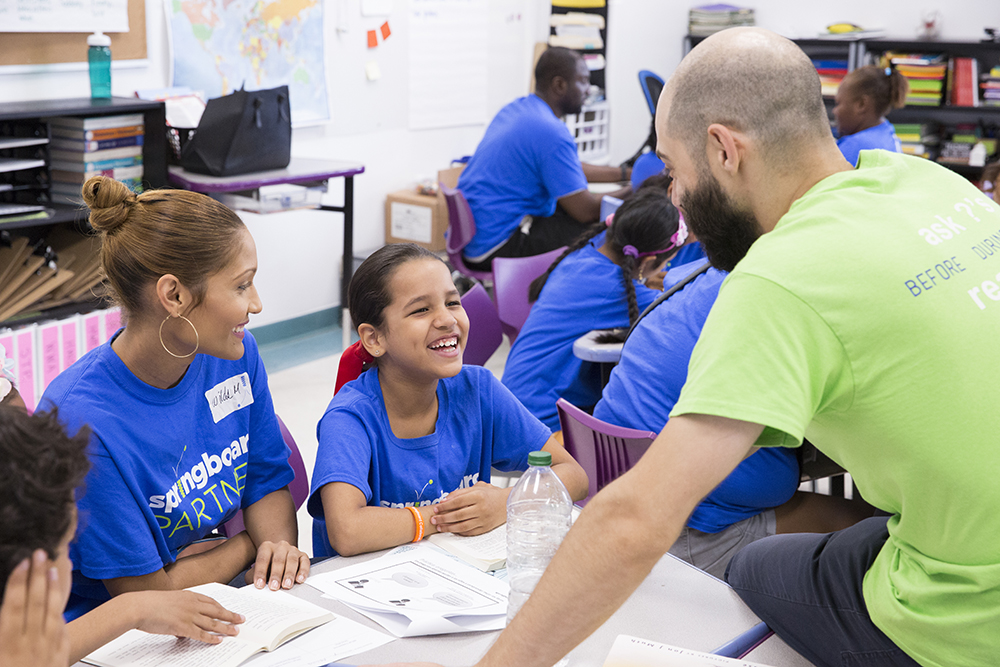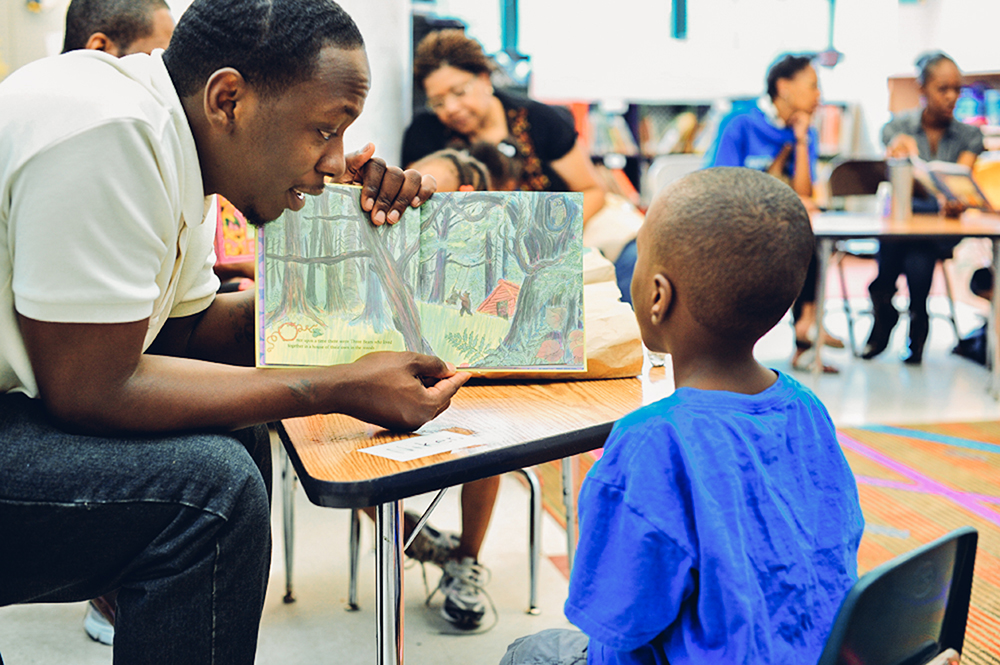
A Springboard teacher coaches a family on their action plan during a workshop.
Credit: Springboard
Over half of fourth graders in the U.S. read below grade level. Reading below grade-level by the end of third grade is one of the earliest predictors that a child is on track to leave high school unprepared for college or a career. This is especially true for students living in poverty; one in six students living in poverty does not even graduate from high school.
For many students, this slippery slope begins in the summer, when low-income kids typically lose months of reading skills. Year after year, low-income students fall further and further behind their wealthier peers because the summer represents one step back for every two steps forward gained during the school year. One study concluded that two-thirds of the achievement gap among high school students is attributable to summer learning loss in elementary school.
The persistent literacy gap between lower-income students and their higher-income peers speaks to a larger issue, however. It is symptomatic of an underlying challenge: schools struggle to bring low-income parents into the process of teaching kids. As a result, we fail to capture educational value from the place children have most of their formative experiences: the home.
Children spend 75 percent of their waking hours outside of the classroom, yet our nation does shockingly little to capture educational value from this time for low-income kids. Too often we treat their families as liabilities, rather than assets. Why don’t we see in a low-income parent the very same love, commitment, and potential we see in a wealthier parent? Many of the families Springboard works with have learned the hard way just how important it is for their children to have a better educational experience than they did. In their determination, there is boundless potential.
It may sound like an obvious question, but think for a moment: why is it important to involve families in the battle to close the literacy gap?
The best way to become a strong reader is to read, and read, and read some more. For some children, it may seem like a reading habit magically happens, but it’s not magic at all. Who is making sure that the child has something to read? Who is setting aside time in the day, even during the summer, for that child to read? Who is helping that child to keep going when the reading gets tougher? The answer -- the caring adults in their life.
The children enrolled in Springboard programs lack the literacy skills they need to read on grade-level. However, they do not lack caring adults in their lives. And so, Springboard builds on this underutilized and undervalued natural resource in education -- namely the parents and families of our students -- with promising results.
We Work to Close the Literacy Gap
At Springboard, we leverage families to help us attack the literacy gap on three fronts:
- Springboard Summer is an intensive, five-week summer program that combines daily reading instruction for Pre-K through 3rd graders, weekly workshops training parents to teach reading at home, and an incentive structure that awards learning tools to families -- from books to tablets -- in proportion with their children’s reading progress.
- Recognizing that bottom-quartile readers need additional support, we developed Springboard Afterschool, which trains teachers to differentiate instruction and engage families in order to accelerate struggling readers’ progress during the academic year.
- Springboard’s summer and afterschool programs build the requisite mindsets and skillsets to embrace a culture change around parent engagement. Springboard Schoolyear is a blueprint that embeds literacy-focused family engagement into the academic year.
It is important to note that at Springboard we don’t swoop in and give school communities a makeover. Instead, we train teachers and leaders from within the community to create fruitful partnerships with families.

A father practices asking comprehension questions while his son reads.
Credit: Springboard
Our Innovation Solution: We Create Family Partners
Partnership: this word is used -- perhaps overused -- to mean many different things. At Springboard Collaborative, here’s how we think about it:
First, we acknowledge and respect the unique position families have in their children’s lives. This begins with a home visit. 70 percent of families in our program welcome their child’s teacher into their home. This personal interaction provides the foundation for a truly effective partnership focused on the needs of each individual student. Then teachers create personalized student action plans, which they share and refine with families. During the 2017-18 implementation of Springboard Schoolyear, every single family received a student action plan, and 96 percent of families reported that they "understand exactly what [their] child needs to do to become a better reader." Because of these home visits and the customized approach to learning, Springboard families know they are valued and respected.
Second, we recognize that literacy coaching is a specialized skill that can be taught. Each week, our families attend a family workshop. Each hour-long seminar focuses on a different literacy skill that that the families can work on at home. Our weekly family training workshops average an impressive 91 percent attendance. Over and over again, low-income parents prove themselves enthusiastic and effective home literacy coaches.
You can’t build literacy skills and cultivate good reading habits without resources. With this in mind, we provide families with brand new books that are targeted to students’ reading levels. Springboard distributed 36,314 books this summer, an average of 10 books per student, increasing families' at-home libraries by 30 percent.
Third, we recognize that communicating and working with families requires educators to shift their thinking. We train teachers and leaders to create student actions plans, lead family workshops, and communicate with families. As a result, 96 percent of site leaders said they improved in their ability to communicate and engage with families. When these same teachers and leaders return to the school in the fall, they are empowered with the skills and knowledge they picked up over the summer.
Lastly, we expect big things. Participating in the Springboard program is not easy. We ask parents to come to workshops, try out new literacy skills, and dedicate time every day to cultivate good reading habits with their children. And families rise to the challenge.
Before Springboard, 14 percent of our families were reading with their kids 0-1 day a week and a little more than a third of families (36 percent) were reading with their kids more than five days each week. During the Springboard program we increased the number of families consistently reading with their children (more than five days a week) to a whopping 66 percent. The number of families reading very little with their kids (0-1 day a week) dropped to a mere four percent.
Results that Extend Beyond the Home
Springboard’s combination of individualized literacy instruction with robust parent engagement pays off. Working together, we are able to replace the typical three-month summer learning loss with a more than month summer learning gain. Springboard scholars, the same students who were at risk for getting lost in the literacy gap, start the school year reading on grade level and sometimes even months ahead.
And these results have staying power. Six months after completing Springboard, 67 percent of scholars regularly read 4 or more days per week (a sustained 14 percent increase), and they read with more stamina. In fact, 78 percent of scholars regularly read more than 10 minutes every time they sit down to read (a 25 percent increase in the amount of time spent reading).
Who do you think is driving this sustained reading effort at home? It’s no longer the Springboard teacher. The Springboard teacher set the course over the summer, but does not necessarily work with the same group of students thereafter. It’s the family members -- the home literacy coaches -- that sustain habits with the children they love so deeply. During focus groups, we often ask parents: “Of everything you got at Springboard, what most helped you to support your child’s reading progress?” Invariably, the answer is “the practice of setting and achieving goals with my child.” This fundamental practice will not only help children to become strong readers; it will help children to access life opportunities and realize their full potential.
The impact of Springboard families isn’t confined within the walls of the home. As one parent noted, “These things we are learning are very exciting to me and I take them home to my sister, who has a little boy who's about to go into kindergarten. So the skills don’t just go to me; they go to the whole family, the whole block really.”
Springboard Collaborative is proving that family engagement represents the largest opportunity for low-income schools to dramatically improve educational outcomes. It took a long time for the education field to embrace the idea that all children can learn. It is Springboard’s ambition -- and our charge -- to prove that all parents can teach.

Authors' bios
Alejandro Gibes de Gac is the CEO and Founder of Springboard Collaborative. As the son of immigrants who sacrificed everything to give him educational opportunities, Alejandro learned firsthand the potential in parent engagement.
Amanda Hamilton Roos is an education consultant specializing in family engagement and literacy. As an experienced teacher and parent of three, she knows the power of parental love from both sides of the classroom door.
Works Cited
1. Donald J. Hernandez, “Double Jeopardy: How Third-Grade Reading Skills and Poverty Influence High School Graduation,” ERIC: Institute of Education Science, April 2011, https://eric.ed.gov/?id=ED518818.
2. “Our Impact,” Springboard Collaborative, accessed May 6, 2018, https://www.springboardcollaborative.org
3. “Statistics,” The National Children’s Book and Literacy Alliance, accessed May 6, 2018, http://thencbla.org.


